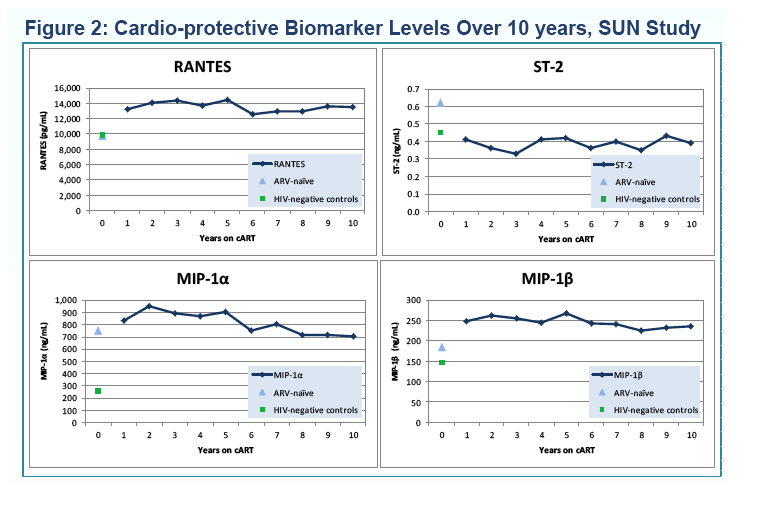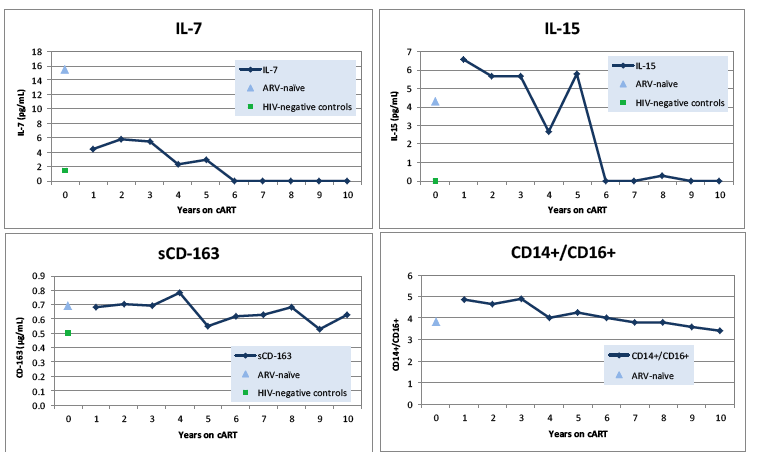 |
 |
 |
| |
Early ART, Acute HIV & Chronic HIV & Inflammation/Activation, the Gut (Microbial Translocation): "Inflammatory Biomarkers Decline but Do Not Normalize after 10 Years of cART "....."Inflammation Persists Despite Early Initiation of ART in Acute HIV Infection"...... Inflammation in Acute HIV Infection Correlates with Blood and Gut CD4 T-cell Loss and HIV Viral Burden"
|
| |
| |
At CROI 2015, this oral talk was presented: "Inflammation Persists Despite Early Initiation of ART in Acute HIV Infection" [http://www.croiwebcasts.org/console/player/25573?mediaType=slideVideo&]. They found: despite suppressive ART in acute infection inflammation persists with some improvements in general but not to levels of uninfected individuals (see slide just below). program abstract: Twenty subjects were diagnosed in 4th generation (4thG) stage 1 (median 12 days post-acquisition), 15 in stage 2 (16 days) and 43 in stage 3 (18 days). All week 0 biomarker levels were significantly higher in HIV+ than HIV- subjects (see table). I-FABP increased by week 2 and remained elevated regardless of 4thG stage. Other biomarkers did not decrease in individuals diagnosed in 4thG1 until week 12. sCD14, CRP and HA decreased by week 2 in individuals diagnosed in 4thG2, and sCD14, CRP, HA and D-dimer decreased by week 2 in individuals diagnosed in 4thG3. HIV+ subjects had significantly higher levels of all biomarkers except D-dimer after 48 and after 96 weeks of ART compared to HIV- subjects. Conclusions: Enterocyte turnover increases after initiation of ART during acute infection and persists into chronic infection. Biomarkers of inflammation, microbial translocation and fibrosis decrease, but remain elevated compared to HIV- controls with the exception of D-dimer. Together, these data suggest that the inflammatory damage caused by HIV may not be completely prevented by starting ART during acute HIV infection.
This was a followup from CROI 2014 where the authors reported: Biomarkers of inflammation, coagulation and fibrosis are elevated in AHI (acute HIV) before seroconversion. The temporal course of these biomarkers suggests that peak viral burden and inflammation trigger a pro-thrombotic and pro-fibrotic response. During acute infection you can see (Figures 2 & 3 below) inflammation markers increased but lower in earliest stage (4) of acute infection and increased markers for microbial translocation (damaged gut).
AND then at CROI 2015 Ken Lichtenstein reported this poster from the SUN Study group (see below): "Inflammatory Biomarkers Decline but Do Not Normalize after 10 Years of cART"

2014 CROI
Inflammation in Acute HIV Infection Correlates with Blood and Gut CD4 T-cell Loss and HIV Viral Burden
http://www.natap.org/2014/CROI/croi_188.htm
"these data suggest that days matter when halting viral replication to reduce the viral reservoir, intestinal CD4 depletion, and inflammation......Plasma levels of biomarkers of inflammation, microbial translocation (MT), fibrosis and coagulation correlated positively with plasma HIV viremia.....and with sigmoid HIV DNA levels"






------------------------------
Inflammatory Biomarkers Decline but Do Not Normalize after 10 Years of cART
KA Lichtenstein1, R Alam1, C Armon2, V Knight1, L Shapiro3, G Pott3, P Merkel1 1Department of Medicine, National Jewish Health, Denver, CO; 2Department of Epidemiology, Children's Hospital Colorado, Aurora, CO; 3Veterans Administration Medical Center, Denver, CO
Background: HIV infection is characterized by a state of chronic inflammation (CI). The degree to which combination antiretroviral therapy (cART) contributes to or ameliorates CI over time is unclear.
Methods: We measured levels of several inflammatory biomarkers (IB) in the 10 year period following initiation of cART in 327 patients participating in the Study to Understand the Natural History of HIV Infection in the Era of HAART (SUN Study) who had HIV-RNA levels
Results: Over the 10 years following initiation of ART, IB levels in the cART-E group were significantly higher vs. those of HNCs (p
Conclusions: After 10 years of cART, levels of IBs decline but remain elevated vs. HNCs. There were no significant differences in levels seen with PI vs. NNRTI based cART.





|
| |
|
 |
 |
|
|